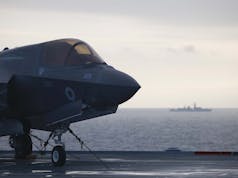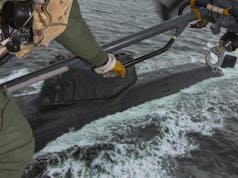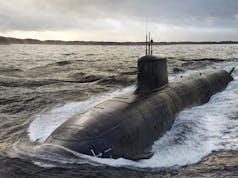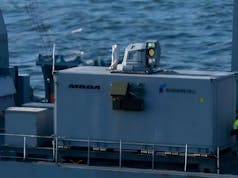The Successor class will replace the Vanguard class submarines from 2028 onwards and will host the United Kingdom’s nuclear deterrent.
The United Kingdom’s nuclear deterrent today is hosted by the Vanguard Class submarine. The class has been purpose-built as a nuclear powered ballistic missile carrier, incorporating a selection of successful design features from other British submarines. Due to this it is quite unlike its predecessor, itself an adaptation of the Valiant class.
The Vanguards were designed and built by Vickers Shipbuilding and Engineering Limited at Barrow-in-Furness. They are by far the largest submarines ever manufactured in the United Kingdom and the third largest unit in the Royal Navy. A special manufacturing facility had to be purpose-built at Barrow for their construction.
The Vanguard Class submarines are larger than the Resolution Class they replaced mainly due to the need to accommodate the Trident D5 missile. However, the crew complement of a Vanguard Class boat is smaller – 132 officers and men compared to a Polaris submarine’s crew of 149. The newer boats include a number of improvements over previous British submarines, including a new design of nuclear propulsion system and a new tactical weapon system for self-defence purposes both before and after missile launch. The 16 tube missile compartment is based on the design of the 24 tube system used by the United States Navy’s Ohio Class Trident submarines.
In August 2003 it was ten years since the lead boat, HMS Vanguard had commissioned. In 2005 she returned to service after completing the first of the two Long Overhaul Periods (the first including a nuclear refuelling) planned during her service life. She was designed with a twenty-five year hull life and thus was expected to require replacement by about 2019, but a less demanding operational profile and deployment cycle than originally anticipated will allow her projected service life to be extended to 2024 if required, and it seems like it will be.
As things stand today, the Astute project currently seems likely to end with the completion and delivery of the seventh hunter-killer around 2019, while the first Vanguard replacement is required in 2021. Government approved initial gate for the successor submarine programme to replace the the Vanguard class in May 2011.
While details remain sketchy at best regarding the currently titled ‘Successor class’, one of the key features the new boats will have is a Common Missile Compartment (CMC). CMC aims to define the missile tubes and accompanying systems that would be used to launch new ballistic missiles, successors to the current Trident II/ D5 missile fleet used by the USA and Britain.
As key trends like cheaper sensors, increasing autonomy and artificial intelligence march onward, the next 40 years will see big changes in the underwater environment. SSBNs will need the flexibility to adapt to these changes if they intend to survive.
For the USA and Britain, the CMC needs to be part of that adaptation. Key options under consideration include a widened diameter for each tube from 2.21m – 3.04m, and the potential for flexibility beyond nuclear missiles, this would provide incredible future-proofing while delivery a (to some unwise), multirole capability.
The British government took the first steps in 2006 towards a joint US-UK missile compartment and the project was launched in 2008, initial gate approval for Britain’s “Successor” project followed in 2011. Other contracts have followed, covering design and even the new kind of nuclear reactor the submarines are expected to use.
There is a precedent for this in the United States, the Virginia Class Block III fast attack submarine replaced their 12 vertical-launch cruise missile tubes with 2 Common Weapon Launcher (CWL). The size of those CWLs allows Virginia Class Block III submarines to launch cruise missiles, UAVs, UUVs, and more from their tubes.
British and American collaboration will also benefit and informs the Successor class missile capability. The 2010 Strategic Defence and Security Review stated the submarine will have eight operational missiles, carrying no more than 40 operational warheads between them. Furthermore, an important feature of the collaboration between the UK and the US has been collaboration between the UK and the US on the new and advanced PWR-3 pressurised water reactor nuclear.
PWR-3, representing the third generation of British pressurised water reactors, builds on cutting edge nuclear propulsion research undertaken by the MoD and Rolls-Royce in the last few decades and is rumoured to be at a very advanced stage of development.
The exact nature of the UK’s industrial access to US reactor technology remains largely unknown in the public domain, the Royal Institution of Naval Architects reported previously that it is likely that the UK has been given a good look at the S9G reactor design that equips the US Navy’s Virginia Class submarines.
Back to the missile compartments, there is no question that the future Common Missile Compartment will be built around the nuclear deterrence mission as its primary focus. That is unlikely to be its sole use, however, and it would not be surprising if some of those other potential uses ended up influencing the CMC’s design. As is the case with a force more focused on multi role capability, versatility is key. Industry is unsurprisingly quiet on the specifics of the engineering and technology but industry has given some intriguing glimpses at what we may see in the water, one day.
According to BAE, the lead partner for the Successor programme, work on the concept design phase had been ongoing since 2007, but this has now completed, and an outline submarine design has been selected.
Following the Government’s approval of the Initial Gate Business Case in May, 2011, the programme moved into the Assessment Phase, which is the first major stage of the new submarine’s design and development. This is where the vessel concept and requirements are fleshed out and finalised into a detailed hull form and systems.
What could the submarine look like? Well, current expectations are that it’ll look like one of the two models that were displayed at the Defence Systems and Equipment International exhibition in 2007. Named ‘Concept 35’ and ‘Advanced Hull Form’, they represent a conservative and radical view of how a future submarine might look and work.
Concept 35 was developed with the same design philosophy to that of the Astute class: drive down costs throughout the boat’s lifetime. One of the key decisions made for this concept included using off-the-shelf components, rather than investing in custom design.
Kevin Young, leader of design improvement at Barrow said:
“We’ve found that it’s a smaller product, it’s quieter, and it’s a lower cost solution than making our own component, because we’re buying from a company that’s made its own investment in R&D, rather than having to spend that money ourselves”
It should be noted that certain design aspects of the Concept 35 design are less conservative. Significant automation techniques would be utilised to a far greater degree for submarine control and condition monitoring. For example, in the nuclear power plant, like modern civil power plants Concept 35 would incorporate passive safety features like coolant valves that automatically open if they fail, rather than close, so that coolant can still reach the reactor core.
The far more ambitious proposal was the Advanced Hull Form submarine concept. The design is clearly very different from any submarine in the oceans. With an oval cross-section rather than cylindrical, the hull splits into a Y at the stern with the propulsors mounted inside angular ducts that are integrated into the hull itself.
It’s been said by BAE that the resulting unusual hull offers a great deal of advantages in terms of noise signature, manoeuvring and offers large volumes for payloads and equipment outside the pressure hull. Furthermore, it has reportedly been designed for relatively low cost construction using largely flat or single curvature surfaces. This approach also allows rapid repair and modification, giving the basis for a flexible and economical platform through life.
First Sea Lord, Admiral Sir Mark Stanhope recently commented that
“The Royal Navy has been operating continuous at-sea deterrent patrols for more than 40 years, the Successor submarines will allow us to do so well into the future with cutting-edge equipment.”
Successor is now in the detailed design stage and it is expected to begin delivery in 2028. It is expected to be the most technologically advanced submarine in the history of the Royal Navy, the name of the class has not yet been revealed.













Alway thought you had a bit of navy in you pal 🙂 lol
Craig Newey Simon Bingley Matthew Gavin
[…] Public domain details of what the Successors will be are pretty scant and it seems as if that may be the actual situation. We do know that they will share with the American submarines a common missile compartment and probably common launch tubes. This is imperative where the UK buys the missiles from the USA but it is an imperative that, bizarrely, was very belatedly recognised. [For those interested in this there is a useful piece here, from April 2015, in the UK Defence Journal.] […]
Maybe time to bring back the name Warspite?
I heard they were to be called Poseidon, Perseus, Proteus and Pandora
Hi,I check your blog named “A guide to the Successor class submarine” daily.Your writing style is awesome, keep doing what you’re doing! And you can look our website about fast proxy list.